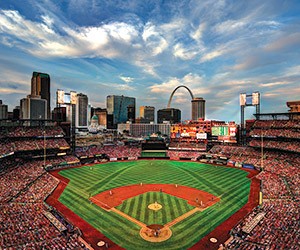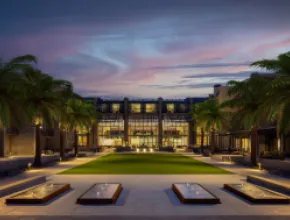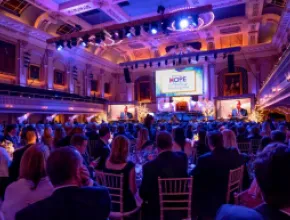Missouri’s nickname, the Show-Me State, appears on its license plates but doesn’t give potential visitors many hints about what they’ll be shown.
Topping the list is the state’s lengthy roster of cultural attractions, which range from giant ballparks and monuments to America’s westward expansion to well-stocked museums and a nature center sited on some of America’s most unique habitat.
Missouri can’t fit all that on a license plate, so we’ve grouped a few of our favorite Missouri draws below.
Sports
While Missouri’s pro football teams—the St. Louis Rams and Kansas City Chiefs—haven’t been champions recently, its pro baseball teams are a different story.
On Missouri’s East Coast, the St. Louis Cardinals are one of pro sports’ most storied franchises, with its most recent World Series titles coming in 2006 and 2011. To say the team is beloved here understates the case; more than 3.5 million fans attended Cardinals home games in 2014.
The Cards’ Busch Stadium is fairly cozy with just under 44,000 seats, offering fans a panoramic view of downtown St. Louis and the Gateway Arch. Groups can take advantage of an 80-capacity conference center, take customized stadium tours and either hit in the clubhouse batting cages or pitch in the bullpen. The adjacent Ballpark Village district is home to the Cardinals Hall of Fame and Museum and the Cardinals Nation restaurant, as well as many other entertainment and dining options.
On Missouri’s West Coast are the Kansas City Royals, who until recently hadn’t been on other teams’ radar as a major threat. That changed in 2014, when strings of thrilling come-from-behind wins vaulted the Royals into the World Series. Although the team eventually lost to San Francisco, the Royals regained their pride and are considered 2015 contenders.
The Royals’ Kauffman Stadium is a great place to watch a game. Besides a built-in conference center, it features the Royals’ Hall of Fame and one of the world’s largest fountains.
Arts
The Nelson-Atkins Museum of Art is Kansas City’s biggest cultural draw for good reason. It documents 5,000 years of world art history through a carefully managed collection of 34,500 artifacts. That includes everything from paintings by Missouri native Thomas Hart Benton and Caravaggio’s St. John the Baptist in the Wilderness to bronze Chinese burial vessels and cutting-edge chef Ferran Adria’s first exhibit of drawings, Notes on Creativity. Planners can host lunches, dinners or cocktail receptions in certain galleries or the Nelson-Atkins’ Rozzelle Court Restaurant.
In southwest Missouri, Springfield hosts the Springfield Art Museum, where an American-art focus is augmented with collections of Asian porcelains, textiles and decorative arts. Docent-led private tours are available.
Westward Expansion
St. Charles is where President Thomas Jefferson’s personal secretary, Meriwether Lewis, met up with William Clark to begin a years-long journey to the Pacific Ocean and back. What’s now known as the Lewis & Clark Expedition is commemorated here by a statue of the two explorers and the Lewis & Clark Boat House and Nature Center, which has replicas of the vessels used to paddle toward the Missouri River’s headwaters. St. Charles has taken pains to preserve its historic downtown, with brick-paved streets and an eclectic collection of shops and restaurants.
Just 50 or so years after the Lewis & Clark Expedition’s success, the Pony Express was the only reliable means of transcontinental communication, and St. Joseph was its eastern terminus.
During a remarkable 18-month period from 1860 to 1861, a stream of riders galloped between 157 stations placed 5 to 25 miles apart, switched out their tired horse for a fresh one, and galloped off to the next station. Today, the Pony Express National Museum occupies the site of the Pike’s Peak Stables, where visitors can view exhibits illustrating how the system made it the FedEx of its day.
Monuments
The 630-foot, shimmering, stainless-steel Gateway Arch long ago transcended its original mission of commemorating St. Louis’ role as the starting point for journeys to the far West, and now represents the city itself, says Anthony Paraino, director of communications for the St. Louis Convention & Visitors Commission.
PageBreak
“It is so recognizable as a symbol of St. Louis, Missouri and the entire nation,” he says.
Groups can get great views of the Arch and St. Louis’ skyline from the replica paddlewheel riverboats Tom Sawyer and Becky Thatcher, which also feature talks by National Park Service rangers.
If the Arch symbolizes St. Louis, the Missouri State Capitol in Jefferson City is as Missourian as can be. Finished in 1917, its Classical Revival style is superficially similar to the U.S. Capitol in Washington, D.C. The capitol and its grounds are packed with paintings, statuary and other monuments that tell Missouri’s history.
Getting Outside
When you talk about getting outside in Missouri, Lake of the Ozarks is probably the first name that comes up. It has a surface area of 55,000 acres and a serpentine, 1,150-mile shoreline, just a few miles less than the driving distance from Kansas City to New York City. Attractions here include three golf courses, Lake of the Ozarks State Park and towns such as Osage and Lake of the Ozarks. which offer shopping and meetings-friendly lodgings.
The University of Missouri is an important emblem of Missouri’s agricultural roots and its host city of Columbia, says Megan McConachie, marketing and communications manager at the Columbia CVB.
“MU is the oldest land-grant university west of the Mississippi, and its campus in its entirety is designated as a botanic garden,” she says. “And it’s home to dozens of historic buildings.”
Hour-long walking tours of the campus help introduce the “Mizzou” gardens, but planners can arrange more involved guided tours of 11 thematic and seven special-collection gardens.
Over in Joplin, visitors can check out the Wildcat Glades Conversation & Audubon Center. The center’s trails, terrarium and aquarium show off some of the area’s unique animal and plant species.
Entertainment
Along with Chicago and New Orleans, St. Louis is one of the nation’s blues treasure houses, and visitors won’t go wrong on any given night visiting the Broadway “blues triangle,” consisting of Beale on Broadway, Broadway Oyster Bar and BB’s Jazz, Blues and Soups. All serve food alongside local, regional and national sounds.
While the blues are just one facet of St. Louis, entertainment dominates Branson, which may feature the largest array of musical and theater acts in the U.S. At least a dozen major shows are on tap at different venues each night.
PAUL D. KRETKOWSKI is a frequent contributor to Meetings Focus.






